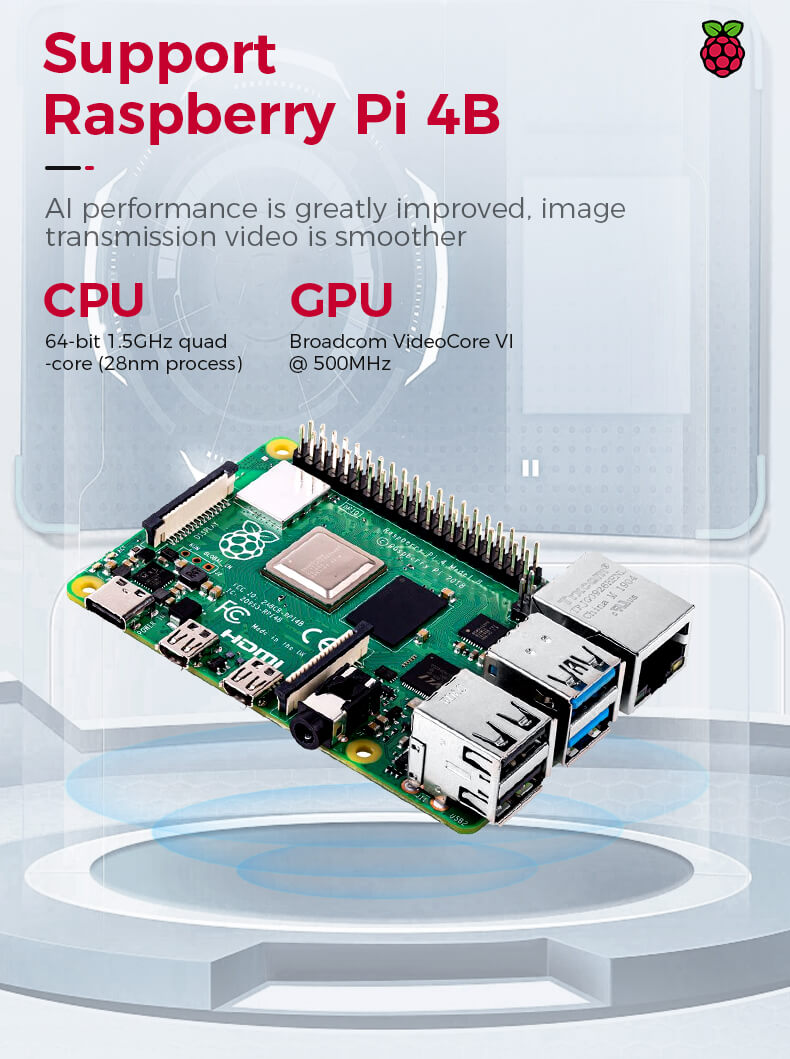Raspberry Pi, as a small, low-power, high-performance computer motherboard, has been favored by developers and enthusiasts for its powerful functions and wide range of application scenarios since its inception. In recent years, with the rapid development of robotics technology, Raspberry Pi has gradually become an important tool in the field of programming robots. This article will introduce you to the characteristics, advantages and application scenarios of Raspberry Pi programming robots.
1. Characteristics of Raspberry Pi programming robot
Versatility: The Raspberry Pi has enough computing power to handle various tasks required for robots, such as controlling motors, processing sensor data, executing algorithms, etc. This enables Raspberry Pi-programmed robots to achieve complex movement and interaction functions.
Strong scalability: Raspberry Pi can connect various sensors, motor driver boards and other electronic components through GPIO (General Purpose Input and Output) pins. This high degree of scalability allows the Raspberry Pi programming robot to be customized according to needs and achieve more diverse functions.
Flexible programming: Raspberry Pi supports multiple programming languages, such as Python, C++, Java, etc. This makes writing software to control robots more flexible and convenient. Developers can choose the appropriate programming language based on their familiarity and project needs.
2. Advantages of Raspberry Pi programming robot
Low cost: Compared with traditional robot hardware platforms, the Raspberry Pi is more affordable. This enables more people to access and understand robotics technology and lowers the threshold for learning and research.
Easy to get started: Raspberry Pi comes with extensive development resources and community support. Developers can easily find various tutorials, sample codes and solutions to quickly master the development methods of Raspberry Pi programming robots.
Wide range of application scenarios: Raspberry Pi programming robots can be used in various fields, such as education, scientific research, entertainment, etc. In the field of education, Raspberry Pi programming robots can help students understand the basic principles and programming methods of robots; in the field of scientific research, Raspberry Pi programming robots can be used to implement various complex experiments and research tasks; in the entertainment field, Raspberry Pi programming robots Programmed robots can provide us with rich and interesting interactive experiences.
3. Application scenarios of Raspberry Pi programming robots
Educational field: Raspberry Pi programming robot can be used as a teaching tool to help students understand the basic principles and programming methods of robots. Through hands-on practice, students can better understand the combination of computer programming and robotics technology, and improve their innovation and practical abilities.
Scientific research field: Raspberry Pi programming robot can be used to implement various complex experiments and research tasks. For example, in fields such as machine learning and artificial intelligence, Raspberry Pi programming robots can be used as experimental platforms to help researchers verify the effectiveness of algorithms and models.
Entertainment field: Raspberry Pi programming robots can provide us with rich and interesting interactive experiences. For example, a desktop robot based on Raspberry Pi can realize offline wake word detection, chat, machine vision and other functions, bringing us a new smart life experience.
4. Recommended Raspberry Pi robot:
XiaoR GEEK series robots:
Raspberry Pi DS smart car programming robot: This car has fine workmanship and sensitive sensors. The chassis has a variety of holes reserved and can be equipped with various sensors according to your own needs. Suitable for beginners to conduct various programming and AI video experiments.
Raspberry Pi DSX smart car programming robot: This car is an upgraded version of DS. The body is made of anodized aluminum alloy, which is lightweight and durable. At the same time, the car body is equipped with a marquee, which can freely compile the colors displayed by the marquee. In addition, the car adds a variety of AI visual recognition functions, making the gameplay richer and suitable for various programming and AI video experiments.
Raspberry Pi TH Smart Car: If you like hardcore and sturdy robots, then this tank-modeled robot car will be a good choice. It features an aluminum chassis and various mounting holes to make it easy to add the sensors or circuit boards the user wants.
Raspberry Pi TH-X smart car: This car is an upgraded version of the Raspberry Pi TH car. It combines the Raspberry Pi 4B/8G motherboard and Python programming, and adds AI visual recognition and open source features. It is also equipped with A 4-degree-of-freedom robotic arm can be used for handling experiments.
Raspberry Pi GFS Smart Video Car: This robot uses a crawler chassis and a 4-degree-of-freedom robotic arm. The chassis has various mounting holes reserved for users to add the desired sensors or circuit boards.
Raspberry Pi GFSX Smart Video Car: This robot is an upgraded version of GFS. It also adds AI artificial intelligence visual recognition function based on the original functions, which is very suitable for users to experience artificial intelligence.
XR-ROS lidar intelligent robot: This robot combines ROS (Robot Operating System) and Python programming, and has functions such as indoor mapping, fixed-point navigation, and secondary path planning. It is easy to install and feature-rich, suitable for both beginners and advanced users.
Raspberry Pi 4B bionic Hexapod spider robot: This bionic robot has 19 servos throughout its body. It not only looks cool like a spider, but also has powerful functions. It supports Python programming and visual recognition, and the store also provides patient guidance, which is very suitable for students.
5. Conclusion
The Raspberry Pi programming robot has become an important tool in the field of robotics due to its versatility, strong scalability and flexible programming. By programming robots with Raspberry Pi, we can realize various complex movements and interactive functions, bringing unlimited possibilities to fields such as education, scientific research, and entertainment. With the continuous advancement of technology and the continuous expansion of application scenarios, I believe that Raspberry Pi programming robots will play a more important role in the future.

